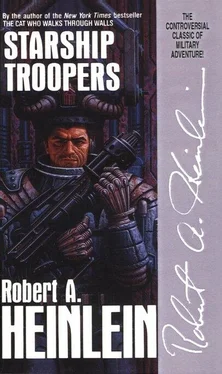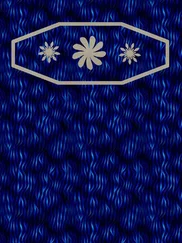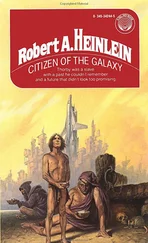The root of our morale is: “Everybody works, everybody fights.” An M.I. doesn’t pull strings to get a soft, safe job; there aren’t any. Oh, a trooper will get away with what he can; any private with enough savvy to mark time to music can think up reasons why he should not clean compartments or break out stores; this is a soldier’s ancient right.
But all “soft, safe” jobs are filled by civilians; that goldbricking private climbs into his capsule certain that everybody , from general to private, is doing it with him. Light-years away and on a different day, or maybe an hour or so later — no matter. What does matter is that everybody drops. This is why he enters the capsule, even though he may not be conscious of it.
If we ever deviate from this, the M.I. will go to pieces. All that holds us together is an idea — one that binds more strongly than steel but its magic power depends on keeping it intact.
It is this “everybody fights” rule that lets the M.I. get by with so few officers.
I know more about this than I want to, because I asked a foolish question in Military History and got stuck with an assignment which forced me to dig up stuff ranging from De Bello Gallico to Tsing’s classic Collapse of the Golden Hegemony . Consider an ideal M.I. division — on paper, because you won’t find one elsewhere. How many officers does it require? Never mind units attached from other corps; they may not be present during a ruckus and they are not like M.I.—the special talents attached to Logistics & Communications are all ranked as officers. If it will make a memory man, a telepath, a senser, or a lucky man happy to have me salute him, I’m glad to oblige; he is more valuable than I am and I could not replace him if I lived to be two hundred. Or take the K-9 Corps, which is 50 per cent “officers” but whose other 50 per cent are neodogs.
None of these is in line of command, so let’s consider only us apes and what it takes to lead us.
This imaginary division has 10,800 men in 216 platoons, each with a lieutenant. Three platoons to a company calls for 72 captains; four companies to a battalion calls for 18 majors or lieutenant colonels. Six regiments with six colonels can form two or three brigades, each with a short general, plus a medium-tall general as top boss.
You wind up with 317 officers out of a total, all ranks, of 11,117.
There are no blank files and every officer commands a team. Officers total 3 per cent — which is what the M.I. does have, but arranged somewhat differently. In fact a good many platoons are commanded by sergeants and many officers “wear more than one hat” in order to fill some utterly necessary staff jobs.
Even a platoon leader should have “staff” — his platoon sergeant.
But he can get by without one and his sergeant can get by without him. But a general must have staff; the job is too big to carry in his hat. He needs a big planning staff and a small combat staff. Since there are never enough officers, the team commanders in his flag transport double as his planning staff and are picked from the M.I.’s best mathematical logicians — then they drop with their own teams. The general drops with a small combat staff, plus a small team of the roughest, on-the-bounce troopers in the M.I. Their job is to keep the general from being bothered by rude strangers while he is managing the battle. Sometimes they succeed.
Besides necessary staff billets, any team larger than a platoon ought to have a deputy commander. But there are never enough officers so we make do with what we’ve got. To fill each necessary combat billet, one job to one officer, would call for a 5 per cent ratio of officers — but 3 per cent is all we’ve got.
In place of that optimax of 5 per cent that the M.I. never can reach, many armies in the past commissioned 10 per cent of their number, or even 15 per cent — and sometimes a preposterous 20 per cent! This sounds like a fairy tale but it was a fact, especially during the XXth century. What kind of an army has more “officers” than corporals? (And more non-coms than privates!)
An army organized to lose wars — if history means anything. An army that is mostly organization, red tape, and overhead, most of whose “soldiers” never fight.
But what do “officers” do who do not command fighting men?
Fiddlework, apparently — officers’ club officer, morale officer, athletics officer, public information officer, recreation officer, PX officer, transportation officer, legal officer, chaplain, assistant chaplain, junior assistant chaplain, officer-in-charge of anything anybody can think of — even nursery officer!
In the M.I., such things are extra duty for combat officers or, if they are real jobs, they are done better and cheaper and without demoralizing a fighting outfit by hiring civilians. But the situation got so smelly in one of the XXth century major powers that real officers, ones who commanded fighting men, were given special insignia to distinguish them from the swarms of swivel-chair hussars.
The scarcity of officers got steadily worse as the war wore on, because the casualty rate is always highest among officers … and the M.I. never commissions a man simply to fill a vacancy. In the long run, each boot regiment must supply its own share of officers and the percentage can’t be raised without lowering the standards — The strike force in the Tours needed thirteen officers — six platoon leaders, two company commanders and two deputies, and a strike force commander staffed by a deputy and an adjutant.
What it had was six … and me.
TABLE OF ORGANIZATION
“Rump Battalion” Strike Force
Cpt. Blackstone (“first hat”)
C Company:
“Warren’s Wolverines”
1st Lt. Warren
1st platoon — 1st Lt. Bayonne
2nd platoon — 2nd Lt. Sukarno
3rd platoon — 2nd Lt. N’gam
D Company:
“Blackie’s Blackguards”
Cpt. Blackstone (“second hat”)
1st platoon — (1st Lt. Silva, in hospital)
2nd platoon — 2nd Lt. Khoroshen
3rd platoon — 2nd Lt. Grahgam
I would have been under Lieutenant Silva, but he left for hospital the day I reported, ill with some sort of twitching awfuls. But this did not necessarily mean that I would get his platoon. A temporary third lieutenant is not considered an asset; Captain Blackstone could place me under Lieutenant Bayonne and put a sergeant in charge of his own first platoon, or even “put on a third hat” and take the platoon himself.
In fact, he did both and nevertheless assigned me as platoon leader of the first platoon of the Blackguards. He did this by borrowing the Wolverine’s best buck sergeant to act as his battalion staffer, then he placed his fleet sergeant as platoon sergeant of his first platoon — a job two grades below his chevrons. Then Captain Blackstone spelled it out for me in a head-shrinking lecture: I would appear on the T.O. as platoon leader, but Blackie himself and the fleet sergeant would run the platoon.
As long as I behaved myself, I could go through the motions. I would even be allowed to drop as platoon leader — but one word from my platoon sergeant to my company commander and the jaws of the nutcracker would close.
It suited me. It was my platoon as long as I could swing it — and if I couldn’t, the sooner I was shoved aside the better for everybody. Besides, it was a lot less nerve-racking to get a platoon that way than by sudden catastrophe in battle.
I took my job very seriously, for it was my platoon — the T.O. said so. But I had not yet learned to delegate authority and, for about a week, I was around troopers’ country much more than is good for a team. Blackie called me into his stateroom. “Son, what in Ned do you think you are doing?”
Читать дальше












